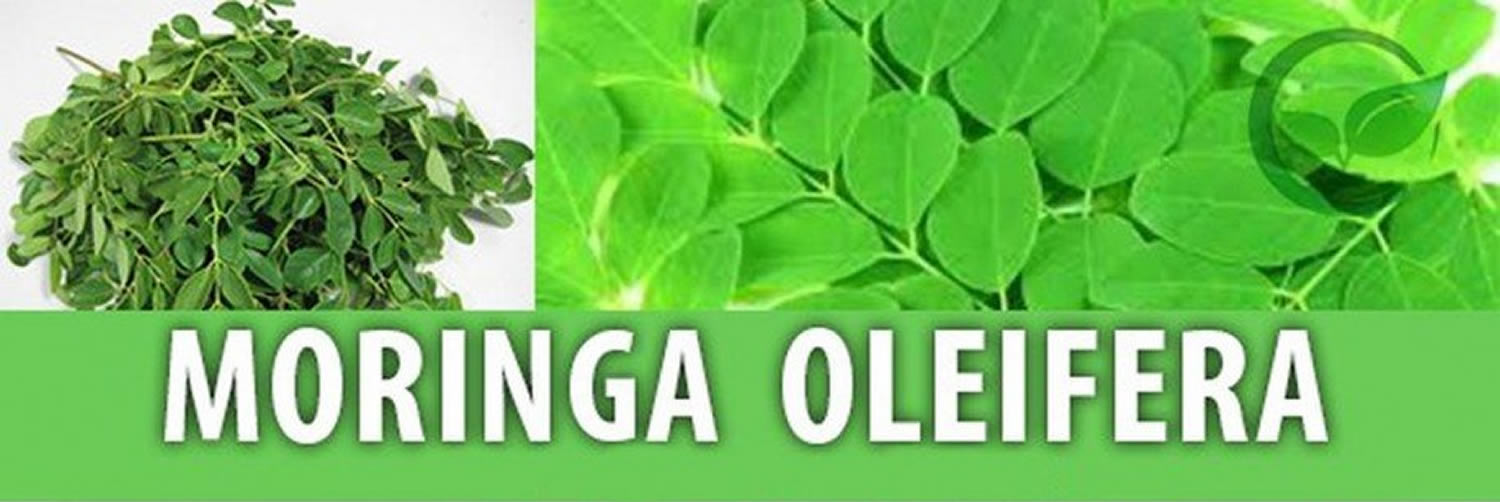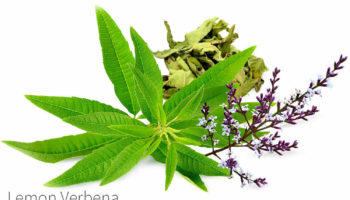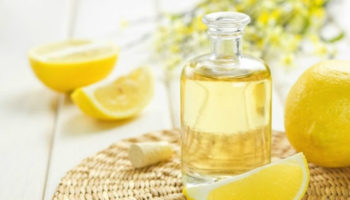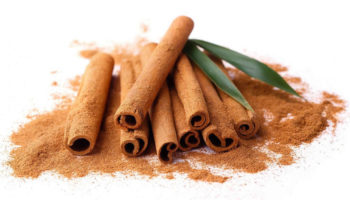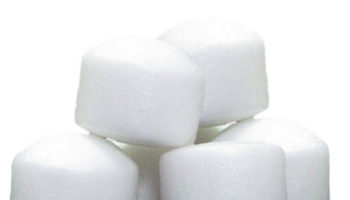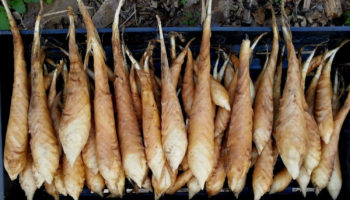Contents
What is moringa
Moringa oleifera Lam., is the only genus in the family Moringaceae, commonly known as the ‘drumstick’ or ‘horseradish’ tree, ben oil tree, or benzoil tree. Moringaceae is a single genus family of shrubs and trees, which comprise of 13 species, distributed in the Indian subcontinent (M. oleifera and M. concanensis), Kenya (M. longituba and M. rivae), northeastern and southwestern Africa (M. stenopetala), Arabia, and Madagascar (M. drouhardii and M. hildebrandtii) 1, 2. The Moringa tree grows best in the temperature range of 25–35 °C, under direct sunlight, at an altitude of 500 m, and in slightly acidic to alkaline soil (pH 5.0–9.0); although it can tolerate excess temperature, up to 48 °C, frost in winter, altitude, and a wide variety of soil conditions 3. Moringa oleifera seeds can be planted just after maturity, as the seeds do not undergo dormancy while retaining viability up to 1 year. The tree starts bearing fruits at an age between six and 8 months, with a low fruit set in the initial one to 2 years, however, the yield increases in the subsequent years. India is the largest producer of Moringa oleifera fruits (pods) with an annual production of 1.1–1.3 million tons from an area of 38,000 ha. In India, the state of Andhra Pradesh is the major producer both area-wise (15665 ha) and in production, followed by Karnataka (10280 ha) and Tamil Nadu (7408 ha) 4.
Moringa oleifera Lam., is recognized as a vibrant and affordable source of phytochemicals, having potential applications in medicines, functional food preparations, water purification, and biodiesel production 3. Moringa oleifera is native of the sub-Himalayan mountains of northern India, but currently it is widely distributed in the Americas, Africa, Europe, Oceania and Asia 5, 6. Leaves, flowers, pods and seeds of Moringa oleifera tree are considered a food source of high nutritional value in the African continent and other countries, particularly in India, Philippines and Pakistan 7. Moringa oleifera is an affordable and readily available source of major essential nutrients and nutraceuticals, and it has the potential to eradicate malnutrition 8. The Moringa is often considered as important famine food because of its high resistance to drought and arid conditions owing to their tuberous roots 1. Almost each and every part of Moringa tree is useful for medicinal, functional food preparations, nutraceuticals, water purification, and biodiesel production; including roots, leaves, flowers, green pods, and seeds 2. The immature pods, flowers, and foliage of this tree are used for culinary purposes in different parts of the world 9. The foliage of Moringa oleifera has been established as a rich source of phenolics and glucosinolates 10, minerals 11, tocopherols 12, carotenoids 13, polyunsaturated fatty acids 14, ascorbic acid 2, and folate 15. It is suggested that Moringa oleifera-based food can be used as a significant source of folate, because of significantly higher bioavailability in animals 15. Moringa seed oil (yield 30–40 % w/w), also known as “Ben oil” is used for the production of biodiesel, because of the high content of monounsaturated fatty acids in the form of oleic acid (C18:1) 16. Moringa seed oil is a potential candidate for biodiesel production, as it meets all the main specifications of the biodiesel standards of US, Germany, and Europe 17. Thus, it has great commercial and industrial importance. The low molecular weight cationic proteins, chitin binding protein isoforms (Mo-CBP3), lectins, napins, mabinlins, and other seed proteins extracted from Moringa oleifera seeds are successfully characterized and used in domestic and industrial water purification, and hardness removal because of the potent antimicrobial and coagulant properties 18. One of the most applied properties of Moringa oleifera is the highly efficient coagulating effect of its seeds, which are used in water treatment. These seeds act as coagulants of organic matter suspended in water and are used in water treatment stations for natural cleaning before performing other cleansing processes. Furthermore, seeds have more stable activity in different pH ranges, when compared to aluminum sulfate, the most frequently used coagulating substance in water treatment stations 19. Moringa oleifera has also been assessed for its potential to treat aquaculture waste water. The results have shown the simultaneous elimination of water turbidity, suspended particles and microorganisms, making it suitable to completely or partly replace the usual coagulating agents, leading to economic, health and environmental gains 20.
All parts of the Moringa tree are edible and have long been consumed by humans. Moringa oleifera leaves can be consumed cooked or fresh and they can be stored as dried powder unrefrigerated with no nutritional losses, for several months 21. Moringa is used worldwide in the traditional medicine, for various health conditions, such as skin infections, anemia, anxiety, asthma, blackheads, blood impurities, bronchitis, catarrh, chest congestion, cholera, infections, fever, glandular, swelling, headaches, abnormal blood pressure, hysteria, pain in joints, pimples, psoriasis, respiratory disorders, scurvy, semen deficiency, sore throat, sprain, tuberculosis, for intestinal worms, lactation, diabetes, and pregnancy 22. In many regions of Africa, it is widely consumed for self-medication by patients affected by diabetes, hypertension, or HIV/AIDS 23. Moringa oil has tremendous cosmetic value and is used in body and hair care as a moisturizer and skin conditioner. It has been shown that aqueous, hydroalcohol, or alcohol extracts of Moringa oleifera leaves possess a wide range of additional biological activities including antioxidant, tissue protective (liver, kidneys, heart, testes, and lungs), analgesic, antiulcer, antihypertensive, radioprotective, and immunomodulatory actions 24. Phytochemical analyses have shown that Moringa oleifera is a rich source of potassium, calcium, phosphorous, iron, vitamins A and D, essential amino acids, as well as known antioxidants, such as β-carotene, vitamin C, and flavonoids 23. A wide variety of polyphenols and phenolic acids as well as flavonoids, glucosinolates, and possibly alkaloids are believed to be responsible for the effects of the plant 24.
Moringa oleifera nutrition facts
Among the several nutrients found in different parts of Moringa oleifera, proteins are the most abundant, accounting for approximately 25% of dry weight 21, and at least 19 amino acids have been identified in this plant (Table 4). Furthermore, Moringa oleifera also contains several minerals and vitamins (Table 1 and 2). Lipids are abundant in seeds, mainly stearic acid, saturated palmitic acid and oleic acid, representing about 30% of dry weight 25. The lipidic compounds linolenic acid and palmitic acid are the main constituents of Moringa oleifera leaves. In addition, the high nutritional content found in dried leaves is an indicator of the usefulness of the plant as a food resource 26.
Different parts of the Moringa oleifera tree have been established as being good sources of unique glucosinolates, flavonoids and phenolic acids 27, carotenoids 13, tocopherols 28, polyunsaturated fatty acids (PUFAs) 14, highly bioavailable minerals 11, and folate 15. Fresh leaves dried by lyophilisation were found best suitable to retain maximum content of trans-luteoxanthin (69.4 %), trans-lutein (51.3 %), trans-β-carotene (89.9 %), total carotenoids (60.6 %), α-tocopherol (86.7 %), ascorbic acid (97.8), chlorophyll a (75.5 %) and chlorophyll b (71.1 %) 29. Trans-lutein, trans-β-carotene and trans-zeaxanthin were found as the major carotenoids in fresh leaves, accounting for 36.9, 18.2 and 5.5 mg/100 g, respectively. Similarly, high amounts of ascorbic acid, α-tocopherol and total phenolic content (271.0, 36.9 and 512.0 mg/100 g), respectively were recorded in leaves. α-tocopherol was the most stable vitamin under all drying conditions (86.4 % retention during oven drying), compare to other studied phytoconstituents. Cabinet tray drying was found as efficient as lyophilisation to retain maximum content of total carotenoids (60.1 %), trans-β-carotene (90.1 %), 13-cis-lutein (93.2 %), and antioxidant activity, however, lutein (51.3 %) and ascorbic acid (97.8 %) was best preserved by lyophilisation. Among glucosinolates, 4-O-(a-L-rhamnopyranosyloxy)-benzylglucosinolate (glucomoringin) is the most predominant in the stem, leaves, flowers, pods and seeds of Moringa oleifera 10. Although in the roots, benzyl glucosinolate (glucotropaeolin) is the most prominent. The highest content of glucosinolate is found in the leaves and seeds. The enzymatic catabolism of glucosinolates by the endogenous plant enzyme myrosinase produces isothiocyanates, nitriles, and thiocarbamates that are known for strong hypotensive (blood pressure lowering) and spasmolytic (muscle relaxant) effects 30. Among flavonoids, flavonol glycosides (glucosides, rutinosides, and malonyl glucosides) of quercetin > kaempferol > isorhamnetin are predominantly found in various parts of the tree, except in the roots and seeds. In the leaves, the amount of quercetin and kaempferol was found to be in the range of 0.07–1.26 and 0.05–0.67 %, respectively. Also, among different varieties, the Indian varieties have shown a higher total content of quercetin and kaempferol, compared to the African indigenous samples 27. The potent antioxidant activity Moringa oleifera is attributed to the high concentration of these polyphenols.
Potassium (K), calcium (Ca), and magnesium (Mg) are the predominant minerals in the Moringa oleifera tissues. The highest content of potassium (K) is found in the vegetative parts and immature pods, whereas, leaves and seeds are a rich source of calcium (Ca) and magnesium (Mg), respectively 10. Moringa oleifera is also recorded as having a rich source of iron (Fe) (17.5 mg/100 g). In a bioavailability study conducted on a rat model, Fe from the Moringa leaf was found to be superior compared to ferric citrate, in overcoming iron deficiency 11.
Table 1. Moringa oleifera leaves (raw) nutrition facts
Nutrient | Unit | Value per 100 g | cup, chopped 21 g | ||||||||||||||||
|---|---|---|---|---|---|---|---|---|---|---|---|---|---|---|---|---|---|---|---|
| Approximates | |||||||||||||||||||
| Water | g | 78.66 | 16.52 | ||||||||||||||||
| Energy | kcal | 64 | 13 | ||||||||||||||||
| Protein | g | 9.40 | 1.97 | ||||||||||||||||
| Total lipid (fat) | g | 1.40 | 0.29 | ||||||||||||||||
| Carbohydrate, by difference | g | 8.28 | 1.74 | ||||||||||||||||
| Fiber, total dietary | g | 2.0 | 0.4 | ||||||||||||||||
| Minerals | |||||||||||||||||||
| Calcium, Ca | mg | 185 | 39 | ||||||||||||||||
| Iron, Fe | mg | 4.00 | 0.84 | ||||||||||||||||
| Magnesium, Mg | mg | 42 | 9 | ||||||||||||||||
| Phosphorus, P | mg | 112 | 24 | ||||||||||||||||
| Potassium, K | mg | 337 | 71 | ||||||||||||||||
| Sodium, Na | mg | 9 | 2 | ||||||||||||||||
| Zinc, Zn | mg | 0.60 | 0.13 | ||||||||||||||||
| Vitamins | |||||||||||||||||||
| Vitamin C, total ascorbic acid | mg | 51.7 | 10.9 | ||||||||||||||||
| Thiamin | mg | 0.257 | 0.054 | ||||||||||||||||
| Riboflavin | mg | 0.660 | 0.139 | ||||||||||||||||
| Niacin | mg | 2.220 | 0.466 | ||||||||||||||||
| Vitamin B-6 | mg | 1.200 | 0.252 | ||||||||||||||||
| Folate, DFE | µg | 40 | 8 | ||||||||||||||||
| Vitamin B-12 | µg | 0.00 | 0.00 | ||||||||||||||||
| Vitamin A, RAE | µg | 378 | 79 | ||||||||||||||||
| Vitamin A, IU | IU | 7564 | 1588 | ||||||||||||||||
| Vitamin D (D2 + D3) | µg | 0.0 | 0.0 | ||||||||||||||||
| Vitamin D | IU | 0 | 0 | ||||||||||||||||
| Lipids | |||||||||||||||||||
| Fatty acids, total trans | g | 0.000 | 0.000 | ||||||||||||||||
| Cholesterol | mg | 0 | 0 | ||||||||||||||||
Table 2. Moringa oleifera pods (raw) nutrition facts
Nutrient | Unit | Value per 100 g | cup slices 100 g | pod (15-1/3″ long) 11 g | |||||||||||||||
|---|---|---|---|---|---|---|---|---|---|---|---|---|---|---|---|---|---|---|---|
| Approximates | |||||||||||||||||||
| Water | g | 88.20 | 88.20 | 9.70 | |||||||||||||||
| Energy | kcal | 37 | 37 | 4 | |||||||||||||||
| Protein | g | 2.10 | 2.10 | 0.23 | |||||||||||||||
| Total lipid (fat) | g | 0.20 | 0.20 | 0.02 | |||||||||||||||
| Carbohydrate, by difference | g | 8.53 | 8.53 | 0.94 | |||||||||||||||
| Fiber, total dietary | g | 3.2 | 3.2 | 0.4 | |||||||||||||||
| Minerals | |||||||||||||||||||
| Calcium, Ca | mg | 30 | 30 | 3 | |||||||||||||||
| Iron, Fe | mg | 0.36 | 0.36 | 0.04 | |||||||||||||||
| Magnesium, Mg | mg | 45 | 45 | 5 | |||||||||||||||
| Phosphorus, P | mg | 50 | 50 | 6 | |||||||||||||||
| Potassium, K | mg | 461 | 461 | 51 | |||||||||||||||
| Sodium, Na | mg | 42 | 42 | 5 | |||||||||||||||
| Zinc, Zn | mg | 0.45 | 0.45 | 0.05 | |||||||||||||||
| Vitamins | |||||||||||||||||||
| Vitamin C, total ascorbic acid | mg | 141.0 | 141.0 | 15.5 | |||||||||||||||
| Thiamin | mg | 0.053 | 0.053 | 0.006 | |||||||||||||||
| Riboflavin | mg | 0.074 | 0.074 | 0.008 | |||||||||||||||
| Niacin | mg | 0.620 | 0.620 | 0.068 | |||||||||||||||
| Vitamin B-6 | mg | 0.120 | 0.120 | 0.013 | |||||||||||||||
| Folate, DFE | µg | 44 | 44 | 5 | |||||||||||||||
| Vitamin B-12 | µg | 0.00 | 0.00 | 0.00 | |||||||||||||||
| Vitamin A, RAE | µg | 4 | 4 | 0 | |||||||||||||||
| Vitamin A, IU | IU | 74 | 74 | 8 | |||||||||||||||
| Vitamin D (D2 + D3) | µg | 0.0 | 0.0 | 0.0 | |||||||||||||||
| Vitamin D | IU | 0 | 0 | 0 | |||||||||||||||
| Lipids | |||||||||||||||||||
| Fatty acids, total saturated | g | 0.033 | 0.033 | 0.004 | |||||||||||||||
| Fatty acids, total monounsaturated | g | 0.102 | 0.102 | 0.011 | |||||||||||||||
| Fatty acids, total polyunsaturated | g | 0.003 | 0.003 | 0.000 | |||||||||||||||
| Fatty acids, total trans | g | 0.000 | 0.000 | 0.000 | |||||||||||||||
| Cholesterol | mg | 0 | 0 | 0 | |||||||||||||||
Table 3. Moringa oleifera leaf powder nutrition facts
Nutrient | Unit | PACKET) | ( 10 g | Value per 100 g | ||||||||||||||||
|---|---|---|---|---|---|---|---|---|---|---|---|---|---|---|---|---|---|---|---|
| Approximates | |||||||||||||||||||
| Energy | kcal | 35 | 350 | ||||||||||||||||
| Protein | g | 3.00 | 30.00 | ||||||||||||||||
| Total lipid (fat) | g | 0.00 | 0.00 | ||||||||||||||||
| Carbohydrate, by difference | g | 5.00 | 50.00 | ||||||||||||||||
| Fiber, total dietary | g | 3.0 | 30.0 | ||||||||||||||||
| Sugars, total | g | 1.00 | 10.00 | ||||||||||||||||
| Minerals | |||||||||||||||||||
| Calcium, Ca | mg | 150 | 1500 | ||||||||||||||||
| Iron, Fe | mg | 45.00 | 450.00 | ||||||||||||||||
| Sodium, Na | mg | 0 | 0 | ||||||||||||||||
| Vitamins | |||||||||||||||||||
| Vitamin C, total ascorbic acid | mg | 0.0 | 0.0 | ||||||||||||||||
| Vitamin A, IU | IU | 5000 | 50000 | ||||||||||||||||
| Lipids | |||||||||||||||||||
| Cholesterol | mg | 0 | 0 | ||||||||||||||||
Table 4. Amino acids of leaves, pods and seeds of Moringa oleifera
| Amino acids | Moringa oleifera (g/100 g) | ||
|---|---|---|---|
| Leaves | Pods | Seeds | |
| Essential | |||
| Arginine | 0.4–1.8 | 0.36 | 4.5 |
| Histidine | 0.1–0.7 | 0.11 | 2.3 |
| Leucine | 0.4–2.2 | 0.65 | 6.7 |
| Lysine | 0.3–1.4 | 0.15 | 1.5 |
| Methionine | 0.1–0.5 | 0.15 | 2.4 |
| Phenylalanine | 0.3–1.6 | 0.43 | 4.0 |
| Threonine | 0.1–1.3 | 0.39 | 3.1 |
| Tryptophan | 0.1–5.2 | ND | 1.6 |
| Valine | 0.4–1.4 | 0.54 | 4.3 |
| Non-Essential | |||
| Alanine | 1.8–3.0 | ND | 6.9 |
| Aspartate | 1.4–2.2 | ND | 5.0 |
| Cysteine | 0.01–0.10 | ND | 2.0 |
| Glutamate | 2.5–2.5 | ND | 20.9 |
| Glycine | 1.3–1.5 | ND | 10.9 |
| Proline | 1.2–1.4 | ND | 4.5 |
| Serine | 1.0–1.2 | ND | 4.4 |
| Tyrosine | 0.01–2.60 | 0.08 | 1.6 |
ND: Not determined.
Figure 1. Moringa oleifera leaves and powder
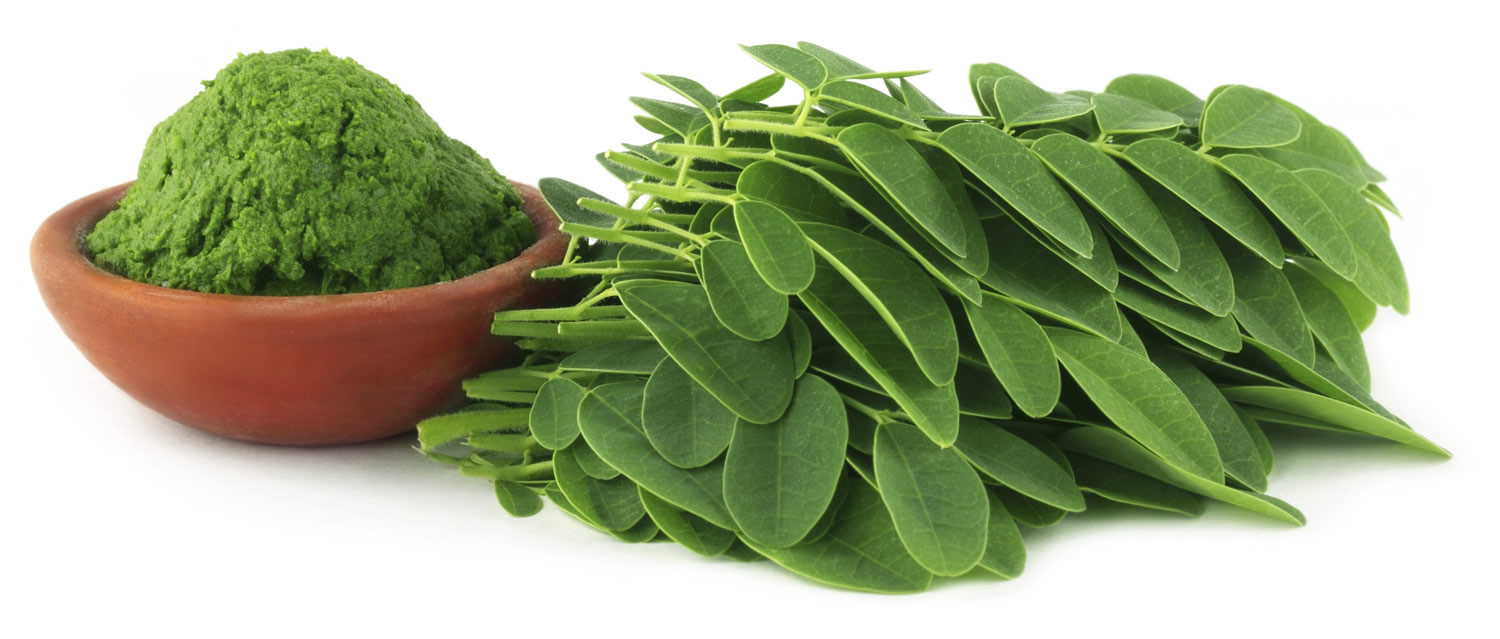
Note: The leaves are the most nutritious part of the plant, being a significant source of B vitamins, vitamin C, provitamin A as beta-carotene, vitamin K, manganese, and protein, among other essential nutrients. When compared with common foods particularly high in certain nutrients per 100 g fresh weight, cooked moringa leaves are considerable sources of these same nutrients. Some of the calcium in moringa leaves is bound as crystals of calcium oxalate though at levels 1/25th to 1/45th of that found in spinach, which is a negligible amount.
The leaves are cooked and used like spinach and are commonly dried and crushed into a powder used in soups and sauces.
Figure 2. Moringa oleifera fruits
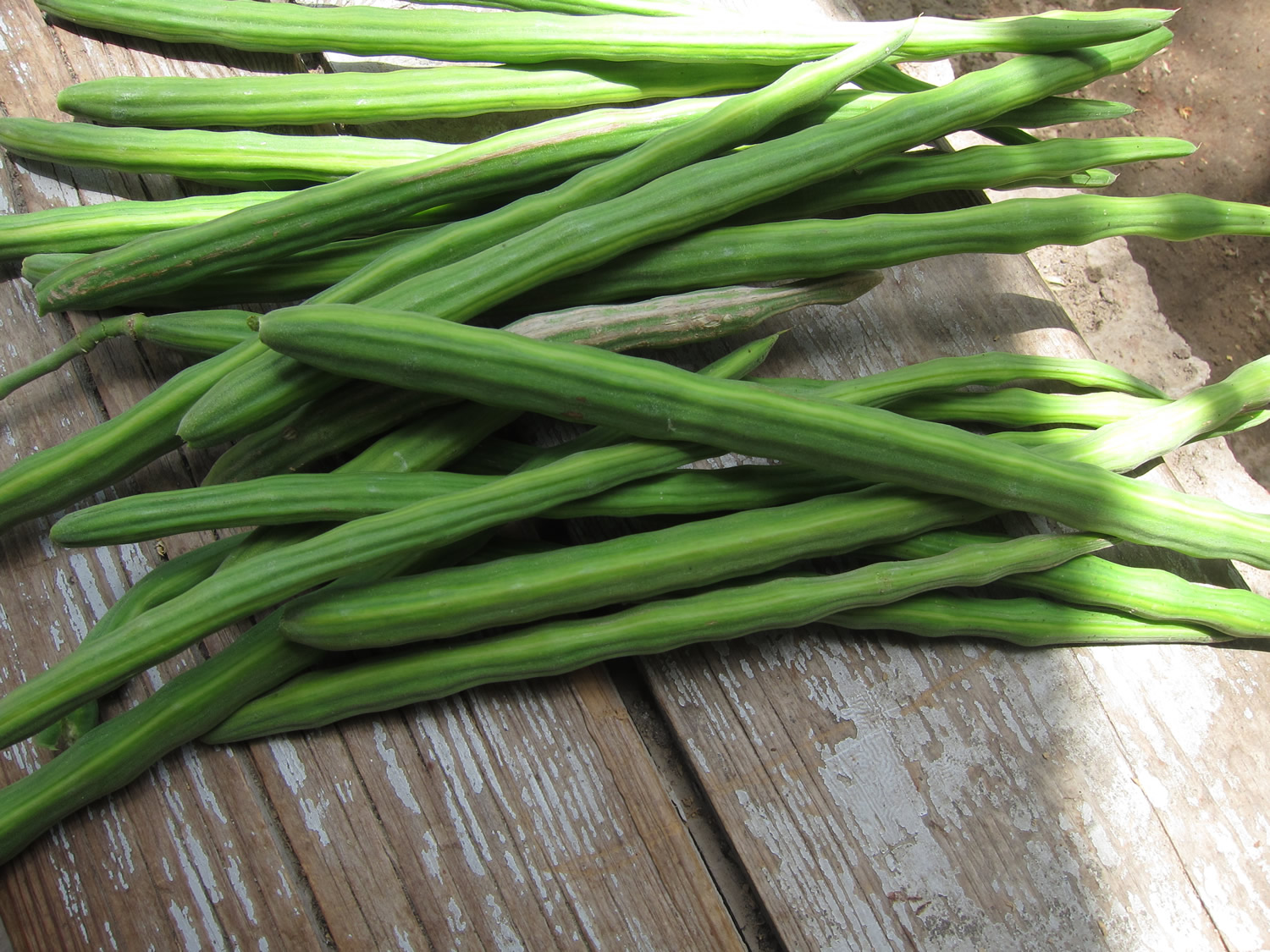
Figure 3. Moringa oleifera seeds
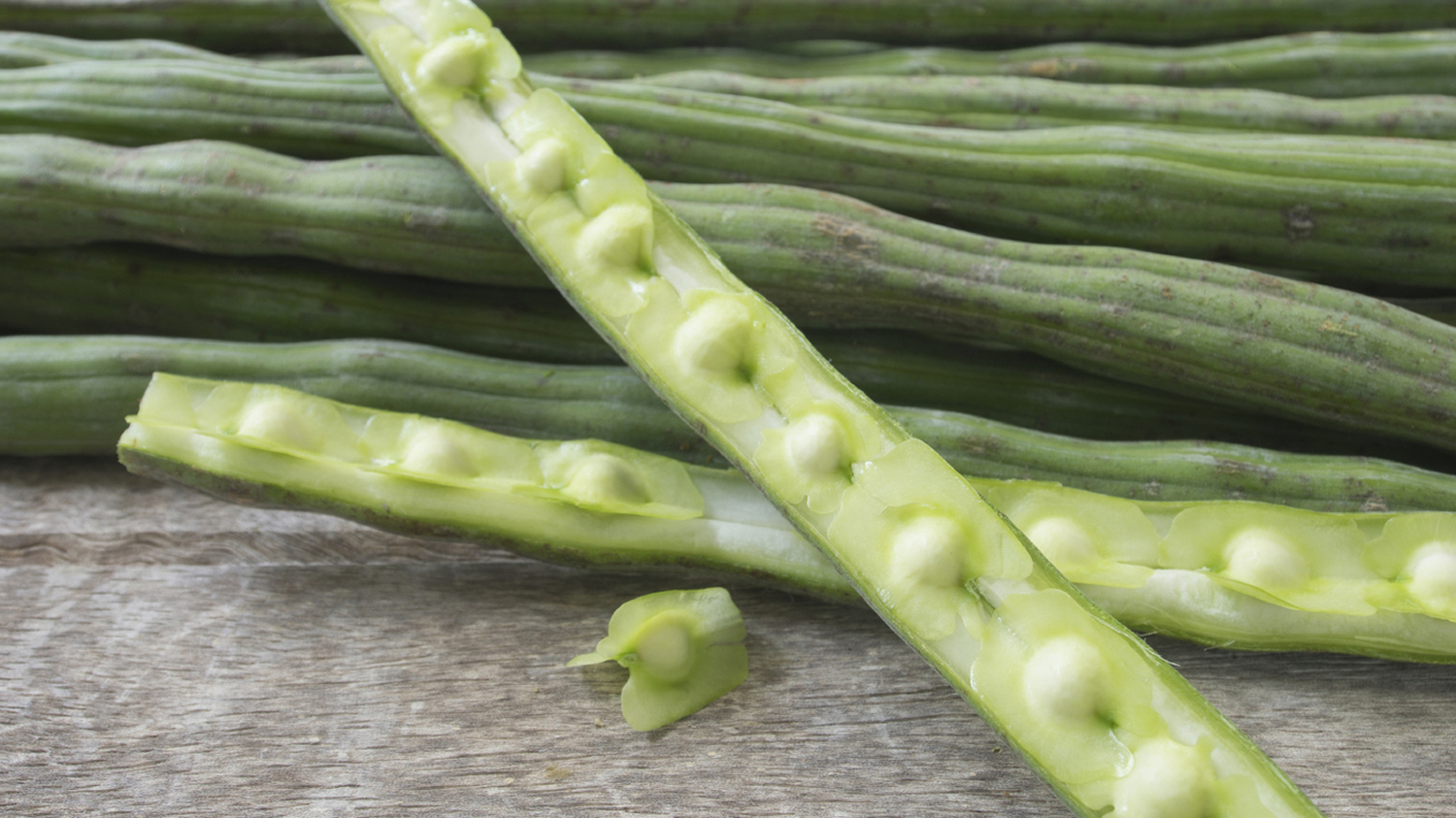
Note: The immature seed pods, called “drumsticks”, are commonly consumed in South Asia. They are prepared by parboiling, and cooked in a curry until soft. The seed pods/fruits, even when cooked by boiling, remain particularly high in vitamin C (which may be degraded variably by cooking) and are also a good source of dietary fiber, potassium, magnesium, and manganese.
Figure 4. Moringa oleifera seeds dried

Note: The seeds, sometimes removed from more mature pods and eaten like peas or roasted like nuts, contain high levels of vitamin C and moderate amounts of B vitamins and dietary minerals.
Figure 5. Moringa Oleifera Oil
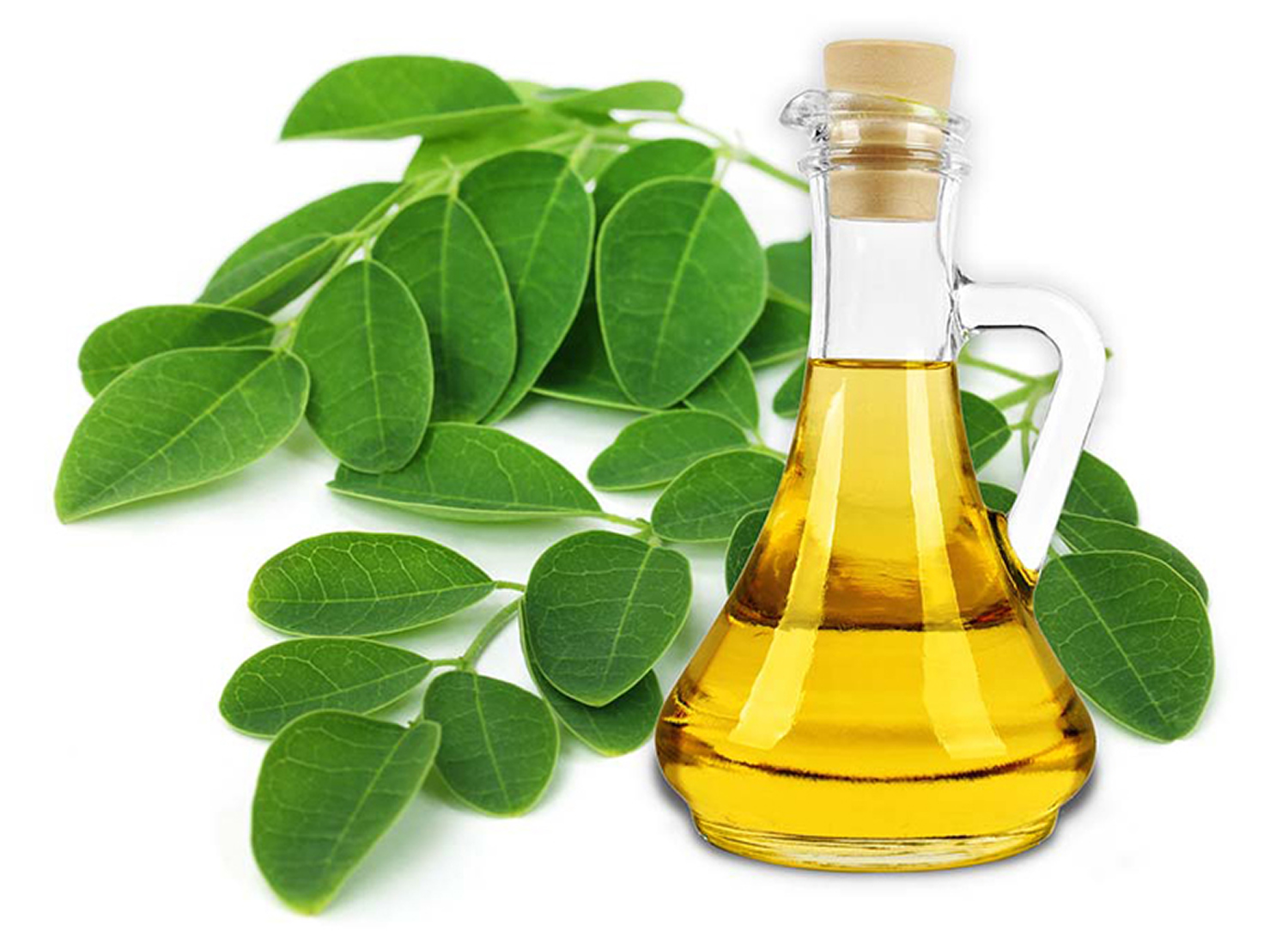
Note: Mature seeds yield 38–40% edible oil called “ben oil” from its high concentration of behenic acid. The refined oil is clear and odorless, and resists rancidity. The seed cake remaining after oil extraction may be used as a fertilizer or as a flocculent to purify water. Moringa seed oil also has potential for use as a biofuel. Biofuel is a renewable and eco-friendly alternative to conventional non-renewable fossil petrodiesel fuel. Azad et al. 33, reviewed the prospect of Moringa oleifera seed oil as a sustainable biodiesel fuel and concluded that MO is one of the prospective industrial crops for biodiesel production in Austria.
Chemical constituents of moringa oleifera
The chemical constituents of moringa oleifera stems, leaves, flowers, pods and seeds have been analyzed for the presence of bioactive compounds, demonstrating the predominance of secondary metabolites, such as phenolic acids, gallic acid, ellagic acid, chlorogenic acid, ferulic acid, glucosinolates, flavonoids, quercetin, vanillin and kaempferol, which have nutritional, pharmaceutical and/or antimicrobial properties 34. However, the amount of these metabolites in moringa oleifera extracts varies according to geographic location, soil, sun exposure and climatic conditions 35. Moreover, the method and solvents used for extraction can modify the content of the compounds obtained from the plant, mainly phenols and flavonoids 36.
Many phytoconstituents of moringa oleifera have been isolated and studied, as shown in Table 5. The main phytochemicals obtained from the plant include:
- tannins, saponins, alkaloids, flavonoids, phenols and glycosides from leaves 37;
- tannins, steroids, flavonoids, alkaloids, glycosides, quercetin and terpenoids from flowers 38;
- gallic acid, catechins, epicatechin, ferulic acid, vanillin, caffeic acid, protocatecuic acid, cinnamic acid, phytosterol, quercetin, glycosides and phenols from seeds 39;
- procyanidins, aurantiamide acetate, 3-dibenzylurea, quercetin glycoside, rhamnoglucoside quercetin, and chlorogenic acid from roots; and procyanidin, sterols, triterpenoids, glycosides, tannins, alkaloids, β-sitosterol and octacosanoic acid from stem bark 40.
Table 5. Phytoconstituents of different parts of Moringa oleifera
Moringa oleifera side effects
No adverse effects were reported in any of the human studies that have been conducted to date 42. Furthermore, various preparations have been and continued to be used around the world as foods and as medicinals without the report of ill effects. Several animal studies have specifically assessed the potential toxicity of various preparations on moringa oleifera.
The safety of an aqueous leaf extract given orally to rats at doses of 400, 800, 1600, and 2000 mg/kg body weight was examined 43. The treatment was either an acute single dose or given daily for 21 days except the highest dose. Various parameters were assessed including blood cell counts and serum enzyme levels. The authors concluded that consumption of M. oleifera leaves at doses of up to 2000 mg/kg were safe. A dose-dependent decrease in body weights of the rats occurred over the 21 days of the study.
Asare et al. 44 examined the potential toxicity of an aqueous leaf extract of moringa oleifera in several different experimental systems. In one set of experiments, human peripheral blood mononuclear cells were exposed in vitro to graded doses of the extract and cytotoxicity was assessed. Cytotoxicity occurred at 20 mg/kg, a concentration not achievable by oral ingestion. In another set of experiments, rats were given 1000 and 3000 mg/kg of the extract, and the animals were assessed for up to 14 days. The M. oleifera leaf extract was shown to be genotoxic based on blood cell analysis at the 3000 mg/kg dose, a dose that greatly exceeds commonly used doses. A dose of 1000 mg/kg was deemed safe and did not produce genotoxicity when given to rats, a dose still in excess of commonly used doses.
Ambi et al. 45 divided 24 rats into four groups and fed varying amounts of M. oleifera powdered leaves mixed with standard livestock feed (25%, 50%, 75%, and control) for 93 days. Total amount of M. oleifera leaves consumed was not quantified. Following the experimental period, some organs of the treated animals had observable microscopic lesions with the 75% group developed necrosis of hepatic cells, splenic blood vessels, and neuronal glial cells. The control animals had no observable microscopic lesions in all organs examined. No photomicrographs of any tissues were provided. The amounts of leaves consumed, although not quantified by the authors, greatly exceeded doses that would be typically used in either rats or humans. For example, if the rats consumed an average of 15–20 g of chow per day, even at the low dose of 25% of the chow, the daily dose would be approximately 15–20 g of leaves per kilogram for an adult rat, which would equate to 195–260 g for an 80-kg human.
The toxicity of an aqueous extract of Moringa oleifera leaves has also been evaluated in mice 46. In an acute study, mice were administered the extract at up to 6400 mg/kg orally and 1500 mg/kg intraperitoneally. In a subchronic study, mice received 250, 500, and 1500 mg/kg orally for 60 days. The lethal dose of 50% LD50 was estimated to be 1585 mg/kg. No significant effects were observed with respect to hematological or biochemical parameters or sperm quality. A high degree of safety was observed on oral administration.
The toxicological effects associated with consumption of 50, 100, 200, or 400 mg/kg of methanol extract of M. oleifera for 8 weeks was performed in 30 rats 47. The extract was a 30:1 concentration. All experimental animals that received M. oleifera had a significant increase in body weight in a dose-dependent manner, contrary to what is observed with an aqueous extract 43. Rats that received Moringa oleifera at 200 and 400 mg/kg showed a significant increase in serum alanine aminotransferase, aspartate aminotransferase, blood urea nitrogen, and creatinine. It should be noted that the extract was prepared with methanol and not water. The 30:1 concentration of the methanol extract at a dose of 400 mg/kg would be equivalent to 12 g of leaves per kilogram, a very unrealistic dose. The composition of the extract was not reported, and it is not clear how the composition of the methanol extract relates to the composition of aqueous extracts, which are commonly used.
Bakre et al. 48 determined that the lethal dose of 50% of an orally administered ethanol extract of Moringa oleifera leaves in mice was greater than 6.4 g/kg. The dietary effects of Moringa oleifera leaves as a dietary supplement for liver function were performed by Zvinorova et al. 49. Thirty-two weanling rats were randomly assigned to diets of normal rat feed fed at 20% and 14% of body mass, or Moringa-supplemented feeds fed at 20% and 14% of body mass for 5 weeks. Moringa supplementation did not affect blood metabolite concentrations, liver glycogen, or lipid storage.
The potential toxicological effects of a single oral dose of 5000 mg/kg of an aqueous Moringa oleifera extract as well as oral doses of up to 1000 mg/kg of the same extract for 14 days on rats were examined 50. The authors noted that no overt adverse reactions were observed at these doses, and no histopathological findings were found. Small but statistically significant dose-dependent increases in several liver enzymes were observed. A dose of 1000 mg/kg in a rat is equivalent to over 30 times a typical 400 mg dose of an aqueous extract in an 80-kg human.
The genotoxicity of an aqueous Moringa oleifera seed extract was assessed using three separate assay systems including the Ames assay 51. The seed extract was not genotoxic without metabolic activation, and did not pose a risk to human health. The effect of a hexane extract of Moringa oleifera leaves on reproductive organs of male rats was examined 52. The extract was given orally at doses of 17, 170, and 1700 mg/kg body weight for 21 days. A dose-dependent increase in testis and epididymis weights, in seminiferous tubule diameter, and epididymal epithelium thickness without change in plasma gonadotropin levels was observed. The authors concluded that the changes were associated with an increase in spermatogenesis.
For the sake of completeness, several studies involving Moringa oleifera seeds and roots will be described, although the results cannot be directly compared or equated with studies involving leaves. Cytotoxicity of an aqueous extract of Moringa oleifera seeds was evaluated by Araújo et al. 53. Following 14 days of the extract administration (500 and 2000 mg/kg) in mice, no signs of systemic toxicity were observed, and all the animals survived. There were no changes in organ indices between treatment and control groups. Small but insignificant changes were observed in erythrocytes, platelets, hemoglobin, and hematocrit. All values remained within the normal range.
A methanol extract of seeds of Moringa oleifera were screened phytochemically for chemical components and used for acute and subacute toxicity studies in rats 54. The phytochemical screening revealed the presence of saponins, tannins, terpenes, alkaloids, flavonoids, carbohydrates, and cardiac glycosides but the absence of anthraquinones. Although signs of acute toxicity were observed at an extract dose of 4000 mg/kg, mortality was recorded at 5000 mg/kg. No adverse effects were observed at concentrations lower than 3000 mg/kg. The authors concluded that methanol extracts of seeds of Moringa oleifera are safe for nutritional use.
Paul and Didia 55 investigated the effect(s) of methanol extract of Moringa oleifera root on the histo-architecture of the liver and kidney of 24 guinea-pigs. Experimental conditions included daily intraperitoneal injections of the root extract at doses of 3.6, 4.6, and 7.0 mg/kg, and control for 3 weeks. Histological sections of all treated groups had ballooning degeneration of the liver, suggesting time-dependent hepatotoxicity rather than a dose-dependent response. Examination of the kidneys, demonstrated mild tubular damage and interstitial inflammation in the 4.6 mg/kg group, while the 7.0 mg/kg group had infiltration of the interstitium by inflammatory cells and amorphous eosinophilic materials. No information was provided regarding extract composition or degree of concentration. The results of this study cannot be compared or equated with studies involving aqueous extracts of leaves. This study involved a methanol extract of roots, which was given intraperitoneally and not orally.
In summary, based on human, animal, and in vitro studies, and the extrapolation of results from animal studies to humans, various preparations of Moringa oleifera leaves including aqueous extracts appear to be safe at the doses and in the amounts commonly utilized 42. Various animal studies have assessed the general safety of extracts. And no adverse effects were reported in a human study conducted with whole leaf powder at up to a single dose of 50 g or in a study using 8 g per day dose for 40 days. A typical dose of an aqueous extract in rats is approximately 300 mg/kg, which would be equivalent to a dose of about 3.9 g in an 80-kg (176 lb) human. No human studies involving aqueous extracts have been reported, and little information is available regarding the percentage of the powdered whole leaf material that is typically solubilized by extraction with water or alcohol. If 10% of the whole leaf powder is solubilized by aqueous extraction, a 4 g dose of the whole leaf powder would equate to 400 mg of an extract 42.
Moringa health benefits
Moringa oleifera has long been used in traditional medicine. The phytochemicals of Moringa oleifera have shown antidyslipidemic, anthelmintic, antihyperglycemic, anti-inflammatory, antimicrobial, antioxidant, antiproliferative, anti-ulcer, antiurolithiatic, and hepatoprotective properties (mostly in test tube and animal stduies – see Table 5). Potent antiproliferative and apoptotic properties of the Moringa oleifera leaf extract, rich in quercetin and kaempferol phenolics compounds, have been demonstrated using the human tumor (KB) cell line model. The Moringa oleifera leaf extract has shown significant morphological changes and decreased cell viability, with increased internucleosomal DNA fragmentation and reactive oxygen species generation in the KB cells 56.
Chronic hyperglycemia is an indicator of diabetes mellitus (type-2 diabetes mellitus), similarly, chronic dyslipidemia is a potential risk factor for cardiovascular disease (coronary heart disease). While data collected from human subjects are limited, several trials demonstrating potential benefits for treating hyperglycemia and dyslipidemia primarily in people with type 2 diabetes have been published.
In a single dose study with six type 2 diabetic subjects, the feeding of 50 g of a M. oleifera leaf powder with a standard meal on a one-time basis decreased blood glucose levels by 21% 57. The authors concluded that the reduced blood glucose response to Moringa oleifera was not due to alterations in insulin secretion.
Kumari 58 treated individuals with type-2 diabetes with 8 g of powdered Moringa oleifera leaf in a tablet form per day for 40 days. A total of 46 subjects were involved in the study. At the end of the study, fasting blood glucose and postprandial blood glucose were 28% and 26% lower, respectively, in the treated subjects. Furthermore, total cholesterol, triglycerides, low density lipoprotein (LDL)-cholesterol, and very low density lipoprotein-cholesterol were 14%, 14%, 29%, and 15% lower relative to the control group.
Nambiar et al. 59 examined the anti-dyslipidemic effects of Moringa oleifera in 35 type 2 diabetic subjects. The treated group received 4.6 g of a leaf powder in a tablet form daily for 50 days. Compared with the control group, the treated subjects experienced a 1.6% decrease in total plasma cholesterol and a 6.3% increase in HDL. Comparing this study with the previous studies suggests that higher doses may be more effective.
Ghiridhari et al. 60 conducted a study in which 60 type 2 diabetic subjects were given two Moringa oleifera leaf powder tablets per day or placebo for up to 3 months. Unfortunately, the weight of the tablets and therefore the actual dose of the leaf powder were not given. After 3 months, postprandial blood glucose had decreased by 29% relative to the control group, while hemoglobin A1C, an index of glycosylation related to blood glucose levels, decreased by 0.4%.
In another human study, Kushwaha et al. 61 studied 30 postmenopausal women who were supplemented daily with 7 g of Moringa oleifera leaf powder for a period of 3 months. A control group also consisted of 30 postmenopausal women. The data revealed significant increases in serum glutathione peroxidase (18.0%), superoxide dismutase (10.4%), and ascorbic acid (44.4%), with decreases in malondialdehyde (16.3%; lipid peroxidation), markers of antioxidant properties. In addition, a significant decrease in fasting blood glucose levels (13.5%) as well as an increase in hemoglobin (17.5%) was observed. No adverse effects were reported.
In summary, the previous human studies indicate that whole leaf powders of Moringa oleifera given orally exhibit significant anti-hyperglycemic, anti-dyslipidemic, and antioxidant effects in human subjects without production of adverse effects 42. None of these studies involved the use of leaf extracts.
Table 6. Biological activities of different extracts of Moringa oleifera
| Extract | Activities | References |
|---|---|---|
| Water extract of foliage | Hypolipidemic and antiatherosclerotic | Chumark et al. 62 |
| Aqueous extract of foliage, fruits, and seeds | Oxidative DNA damage protective | Singh et al. 63 |
| Hydroalcoholic extract of foliage | Antiperoxidative and cardioprotective | Nandave et al. 64 |
| Water extract of foliage | Antiproliferation and apoptosis cancer cells | Sreelatha et al. 65 |
| Hydroethanolic extracts of foliage, fruits, and seeds | Hepatoprotective | Ujah et al. 66 |
| Methanol and ethanol extract of foliage | Inhibition of differentiation of colon cancer cells | Lea et al. 67 |
| Aqueous extract of foliage | Down-regulation of nuclear factor-kappaB | Berkovich et al. 68 |
| Ethanol extract of foliage | Upregulation of TNF-α | Akanni et al. 69 |
| Ethanol extract of foliage | Hypolipidaemic in Hypercholesterolemic Rats | Atsukwei et al. 70 |
| Methanol extract of foliage | Antioxidant, anti-inflammatory and antinociceptive | Adedapo et al. 71 |
| Acetone extracts of foliage | Antimicrobial and antioxidant | Ratshilivha et al. 72 |
| Methanol, ethyl acetate, and aqueous extracts of seeds | Antimicrobial | Emmanuel et al. 73 |
| Isothiocyanate-rich extract of foliage | Weight gain, insulin resistance and hepatic gluconeogenesis | Waterman et al. 74 |
| Ethanol extract of foliage | Antihyperglycemic and hypolipidemic | Irfan et al. 75 |
| Aqueous extract of foliage | Immunity against Herpes Simplex Virus Type 1 (HSV-1) | Kurokawa et al. 76 |
Summary
Moringa oleifera, has nutritional with potential pharmacological and antioxidant properties, thus having several medicinal applications. Moringa oleifera is used in the tropics as a food source to overcome malnutrition, especially in children and infants 77, 78. Among the several nutrients found in different parts of Moringa oleifera, proteins are the most abundant, accounting for approximately 25% of dry weight 21, and at least 19 amino acids have been identified in this plant. Furthermore, Moringa oleifera also contains several minerals and vitamins. Lipids are abundant in seeds, mainly stearic acid, saturated palmitic acid and oleic acid, representing about 30% of dry weight. The lipidic compounds linolenic acid and palmitic acid are the main constituents of Moringa oleifera leaves. In addition, the high nutritional content found in dried leaves is an indicator of the usefulness of the plant as a food resource.
The studies on therapeutic potential of Moringa oleifera leaves in hyperglycemia and dyslipidemia provide compelling, albeit very preliminary, experimental evidence. No report contradicting this evidence was found in the scientific literature. However, a common weakness of all the human studies reviewed herein was the fact that none was randomized and double-blind, raising the possibilities of bias in the allocation of patients to control and experimental groups. Further exploration of the potentials and the eventual use of Moringa oleifera therapy in humans will require that the content in fibers, phytosterols as well in antioxidant and anti-inflammatory activities be evaluated and documented in Moringa oleifera formulations destined to the treatment of atherosclerosis or diabetes.
In conclusion, based on the available experimental evidence, Moringa oleifera leaf powder holds some therapeutic potential for chronic hyperglycemia and hyperlipidemia. However, before it is advocated in any formulation for the treatment of these metabolic disorders in humans, state-of-the art clinical studies must be conducted to establish the consistency of its medicinal efficacy and the safest modalities of its administration 23.
- Padayachee B, Baijnath H. An overview of the medicinal importance of Moringaceae. J Med Plants Res. 2012;6:5831–5839.[↩][↩]
- Saini RK. Studies on enhancement of carotenoids folic acid iron and their bioavailability in Moringa oleifera and in vitro propagation. Mysore: University of Mysore; 2015.[↩][↩][↩]
- Saini RK, Sivanesan I, Keum Y-S. Phytochemicals of Moringa oleifera: a review of their nutritional, therapeutic and industrial significance. 3 Biotech. 2016;6(2):203. doi:10.1007/s13205-016-0526-3. https://www.ncbi.nlm.nih.gov/pmc/articles/PMC5033775/[↩][↩][↩]
- Patel S, Thakur AS, Chandy A, Manigauha A. Moringa oleifera: a review of there medicinal and economical importance to the health and nation. Drug Invent Today. 2010;2:339–342.[↩]
- Moringa (Moringa oleifera Lam.): a versatile tree crop with horticultural potential in the subtropical United States. Hort Sci, 31 (5) (1996), pp. 794-797.[↩]
- Moringa oleifera. T.K. Lim (Ed.), Edible medicinal and non-medicinal plants (1st ed.), Fruits, Vol. 3, Springer, London (2012), pp. 453-485.[↩]
- Biochemical and functional properties of Moringa oleifera leaves and their potential as a functional food. Glob Adv Res J Agric Sci, 4 (4) (2015), pp. 188-199.[↩]
- Kunyanga CN, Imungi JK, Vellingiri V. Nutritional evaluation of indigenous foods with potential food-based solution to alleviate hunger and malnutrition in Kenya. J Appl Biosci. 2013;67:5277–5288. doi: 10.4314/jab.v67i0.95049.[↩]
- Stevens GC, Baiyeri KP, Akinnnagbe O. Ethno-medicinal and culinary uses of Moringa oleifera Lam. in Nigeria. J Med Plants Res. 2013;7:799–804.[↩]
- Amaglo NK, Bennett RN, Lo Curto RB, et al. Profiling selected phytochemicals and nutrients in different tissues of the multipurpose tree Moringa oleifera L., grown in Ghana. Food Chem. 2010;122:1047–1054. doi: 10.1016/j.foodchem.2010.03.073.[↩][↩][↩]
- Dietary iron supplements and Moringa oleifera leaves influence the liver hepcidin messenger RNA expression and biochemical indices of iron status in rats. Saini RK, Manoj P, Shetty NP, Srinivasan K, Giridhar P. Nutr Res. 2014 Jul; 34(7):630-8. https://www.ncbi.nlm.nih.gov/pubmed/25150122/[↩][↩][↩]
- Saini RK, Prashanth KVH, Shetty NP, Giridhar P. Elicitors, SA and MJ enhance carotenoids and tocopherol biosynthesis and expression of antioxidant related genes in Moringa oleifera Lam. leaves. Acta Physiol Plant. 2014;36:2695–2704. doi: 10.1007/s11738-014-1640-7.[↩]
- Saini RK, Shetty NP, Giridhar P. Carotenoid content in vegetative and reproductive parts of commercially grown Moringa oleifera Lam. cultivars from India by LC–APCI–MS. Eur Food Res Technol. 2014;238:971–978. doi: 10.1007/s00217-014-2174-3.[↩][↩]
- Saini RK, Shetty NP, Giridhar P. GC-FID/MS analysis of fatty acids in Indian cultivars of Moringa oleifera: potential sources of PUFA. J Am Oil Chem Soc. 2014;91:1029–1034. doi: 10.1007/s11746-014-2439-9.[↩][↩]
- Relative bioavailability of folate from the traditional food plant Moringa oleifera L. as evaluated in a rat model. Saini RK, Manoj P, Shetty NP, Srinivasan K, Giridhar P. J Food Sci Technol. 2016 Jan; 53(1):511-20. https://www.ncbi.nlm.nih.gov/pmc/articles/PMC4711403/[↩][↩][↩]
- Moringa oleifera oil: a possible source of biodiesel. Rashid U, Anwar F, Moser BR, Knothe G. Bioresour Technol. 2008 Nov; 99(17):8175-9. https://www.ncbi.nlm.nih.gov/pubmed/18474424/[↩]
- Mofijur M, Masjuki HH, Kalam MA, et al. Comparative evaluation of performance and emission characteristics of Moringa oleifera and Palm oil based biodiesel in a diesel engine. Ind Crops Prod. 2014;53:78–84. doi: 10.1016/j.indcrop.2013.12.011.[↩]
- Potential of M. oleifera for the treatment of water and wastewater. Kansal SK, Kumari A. Chem Rev. 2014 May 14; 114(9):4993-5010. https://www.ncbi.nlm.nih.gov/pubmed/24495201/[↩]
- Isolation and characterization of coagulant extracted from Moringa oleifera seed by salt solution. Water Res, 35 (2) (2001), pp. 405-410.[↩]
- Comparison of single-step and two-step purified coagulants from Moringa oleifera seed for turbidity and DOC removal. Bioresour Technol, 101 (15) (2010), pp. 6259-6261.[↩]
- Moringa oleifera: a food plant with multiple medicinal uses. Phyther Res, 21 (1) (2007), pp. 17-25.[↩][↩][↩]
- Safe African Medicinal Plants for Clinical Studies. Toxicological Survey of African Medicinal Plants 2014, Pages 535–555. http://www.sciencedirect.com/science/article/pii/B9780128000182000182[↩]
- Mbikay M. Therapeutic Potential of Moringa oleifera Leaves in Chronic Hyperglycemia and Dyslipidemia: A Review. Frontiers in Pharmacology. 2012;3:24. doi:10.3389/fphar.2012.00024. https://www.ncbi.nlm.nih.gov/pmc/articles/PMC3290775/[↩][↩][↩]
- Stohs, SJ, and Hartman, MJ (2015), Review of the Safety and Efficacy of Moringa oleifera. Phytother. Res., 29, 796–804. http://onlinelibrary.wiley.com/doi/10.1002/ptr.5325/full[↩][↩]
- Some physico-chemical properties of Moringa oleifera seed oil extracted using solvent and aqueous enzymatic methods. Food Chem, 93 (2) (2005), pp. 253-263.[↩]
- Nutritional characterization of moringa (Moringa oleifera Lam.) leaves. Afr J Biotechnol, 10 (60) (2011), pp. 12925-12933.[↩]
- Coppin JP, Xu Y, Chen H, et al. Determination of flavonoids by LC/MS and anti-inflammatory activity in Moringa oleifera. J Funct Foods. 2013;5:1892–1899. doi: 10.1016/j.jff.2013.09.010.[↩][↩]
- Effect of dehydration methods on retention of carotenoids, tocopherols, ascorbic acid and antioxidant activity in Moringa oleifera leaves and preparation of a RTE product. Saini RK, Shetty NP, Prakash M, Giridhar P. J Food Sci Technol. 2014 Sep; 51(9):2176-82. https://www.ncbi.nlm.nih.gov/pmc/articles/PMC4152524/[↩]
- Saini RK, Shetty NP, Prakash M, Giridhar P. Effect of dehydration methods on retention of carotenoids, tocopherols, ascorbic acid and antioxidant activity in Moringa oleifera leaves and preparation of a RTE product. Journal of Food Science and Technology. 2014;51(9):2176-2182. doi:10.1007/s13197-014-1264-3. https://www.ncbi.nlm.nih.gov/pmc/articles/PMC4152524/[↩]
- Moringa oleifera: a food plant with multiple medicinal uses. Anwar F, Latif S, Ashraf M, Gilani AH. Phytother Res. 2007 Jan; 21(1):17-25. https://www.ncbi.nlm.nih.gov/pubmed/17089328/[↩]
- United States Department of Agriculture Agricultural Research Service. National Nutrient Database for Standard Reference Release 28. https://ndb.nal.usda.gov/ndb/search/list[↩][↩][↩]
- Research advances on the multiple uses of Moringa oleifera: A sustainable alternative for socially neglected population. Asian Pacific Journal of Tropical Medicine Volume 10, Issue 7, July 2017, Pages 621-630. https://doi.org/10.1016/j.apjtm.2017.07.002. http://www.sciencedirect.com/science/article/pii/S1995764516307143[↩]
- Azad AK, Rasul MG, Khan MMK, et al. Prospect of Moringa seed oil as a sustainable biodiesel fuel in Australia: a review. Procedia Eng. 2015;105:601–606. doi: 10.1016/j.proeng.2015.05.037.[↩]
- Oxidative DNA damage protective activity, antioxidant and anti-quorum sensing potentials of Moringa oleifera. Food Chem Toxicol, 47 (6) (2009), pp. 1109-1116.[↩]
- Evolution of secondary metabolites from an ecological and molecular phylogenetic perspective. Phytochemistry, 64 (1) (2003), pp. 3-19.[↩]
- Maximizing total phenolics, total flavonoids contents and antioxidant activity of Moringa oleifera leaf extract by the appropriate extraction method. Ind Crops Prod, 44 (2013), pp. 566-571.[↩]
- Phytochemical, nutritional and antibacterial properties of dried leaf powder of Moringa oleifera (Lam.) from Edo Central Province, Nigeria. J Nat Prod Plant Resour, 2 (1) (2012), pp. 107-112.[↩]
- Estimation of total phenolic content, in-vitro antioxidant and anti-inflammatory activity of flowers of Moringa oleifera. Asian Pac J Trop Biomed, 3 (8) (2013), pp. 623-627.[↩]
- Phenolic composition, antioxidant and antimicrobial activities of free and bound phenolic extracts of Moringa oleifera seed flour. J Funct Foods, 5 (4) (2013), pp. 1883-1891.[↩]
- Evaluation of the polyphenol content and antioxidant properties of methanol extracts of the leaves, stem, and root barks of Moringa oleifera Lam. J Med Food, 13 (3) (2010), pp. 710-716.[↩]
- Research advances on the multiple uses of Moringa oleifera: A sustainable alternative for socially neglected population. Asian Pacific Journal of Tropical Medicine Volume 10, Issue 7, July 2017, Pages 621-630. http://www.sciencedirect.com/science/article/pii/S1995764516307143[↩]
- Stohs, SJ, and Hartman, MJ (2015), Review of the Safety and Efficacy of Moringa oleifera. Phytother. Res., 29, 796–804. doi: 10.1002/ptr.5325. http://onlinelibrary.wiley.com/doi/10.1002/ptr.5325/full[↩][↩][↩][↩]
- Adedapo AA, Mogbojuri OM, Emikpe BO. 2009. Safety evaluations of the aqueous extract of the leaves of Moringa oleifera in rats. J Med Plant 3: 586–591.[↩][↩]
- Asare GA, Gyan B, Bugyei K, et al. 2012. Toxicity potentials of the nutraceutical Moringa oleifera at supra-supplementation levels. J Ethnopharmacol 139: 265–272. https://www.ncbi.nlm.nih.gov/pubmed/22101359[↩]
- Ambi AA, Abdurahman EM, Katsayal UA, et al. 2011. Toxicity evaluation of Moringa oleifera leaves. Int J Pharmaceut Res Innovat 4: 22–24.[↩]
- Awodele O, Oreagbe IA, Odoma S, et al. 2012. Toxicological evaluation of the aqueous leaf extract of Moringa oleifera Lam. (Moringaceae). J Ethnopharmacol 139: 300–306.[↩]
- Oyagbemi AA, Omobowale TO, Azeez IO, et al. 2013. Toxicological evaluations of methanolic extract of Moringa oleifera leaves in liver and kidney of male Wistar rats. J Basic Clin Physiol Pharm 24: 307–312.[↩]
- Bakre AG, Aderibigbe AO, Ademowo OG. 2013. Studies on neuropharmacological profile of ethanol extract of Moringa oleifera leaves in mice. J Ethnopharmacol 149: 783–789. https://www.ncbi.nlm.nih.gov/pubmed/23933316[↩]
- Zvinorova PI, Lekhanya L, Erlwanger K, Chivandi E. 2014. Dietary effects of Moringa oleifera leaf powder on growth, gastrointestinal morphometry and blood and liver metabolites in Sprague Dawley rats. J Anim Physiol Anim Nutr. DOI:10.1111/jpn.12182.[↩]
- Asiedu-Gyekye IJ, Frimpong-Manso S, Awortwe C, et al. 2014. Micro- and macroelemental composition and safety evaluation of the nutraceutical Moringa oleifera leaves. J Toxicol. DOI:10.1155/2014/786979. https://www.ncbi.nlm.nih.gov/pmc/articles/PMC4129914/[↩]
- Rolim LA, Macedo MF, Sisenando HA, et al. 2011. Genotoxicity evaluation of Moringa oleifera seed extract and lecithin. J Food Sci 76: T53–T58. https://www.ncbi.nlm.nih.gov/pubmed/21535795[↩]
- Cajuday LA, Pocsidio GL. 2010. Effects of Moringa oleifera Lam (Moringaceae) on the reproduction in male mice (Mus musculus). J Med Plant Res 4: 1115–1121.[↩]
- Araújo LCC, Aguiar JS, Napoleão TH, et al. 2013. Evaluation of cytotoxic and anti-inflammatory activities of extracts and lectins from Moringa oleifera seeds. PLoS One 8: e81973. https://www.ncbi.nlm.nih.gov/pmc/articles/PMC3857229/[↩]
- Ajibade TO, Arowolo R, Olayemi FO. 2013. Phytochemical screening and toxicity studies on the methanol extract of the seeds of Moringa oleifera. J Complement Integr Med 10: 11–16.[↩]
- Paul CW, Didia BC. 2012. The effects of methanolic extract of Moringa oleifera Lam roots on the histology of kidney and liver in guinea pigs. Asian J Med Sci 4: 55–60. https://www.ncbi.nlm.nih.gov/pubmed/7061672[↩]
- Antiproliferation and induction of apoptosis by Moringa oleifera leaf extract on human cancer cells. Sreelatha S, Jeyachitra A, Padma PR. Food Chem Toxicol. 2011 Jun; 49(6):1270-5. https://www.ncbi.nlm.nih.gov/pubmed/21385597/[↩]
- William F, Lakshminarayanan S, Chegu H. 1993. Effect of some Indian vegetables on the glucose and insulin responses in diabetic subjects. Int J Food Sci Nutr 44: 191–196.[↩]
- Kumari DJ. 2010. Hypoglycemic effect of Moringa oleifera and Azadirachta indica in type-2 diabetes. Bioscan 5: 211–214.[↩]
- Nambiar VS, Guin P, Parnami S, Daniel M. 2010. Impact of antioxidants from drumstick leaves on the lipid profile of hyperlipidemics. J Herb Med Toxicol 4: 165–172.[↩]
- Ghiridhari VVA, Malhati D, Geetha K. 2011. Anti-diabetic properties of drumstick (Moringa oleifera) leaf tablets. Int J Health Nutr 2: 1–5.[↩]
- Kushwaha S, Chawla P, Kochhar A. 2012. Effect of supplementation of drumstick (Moringa oleifera) and amaranth (Amaranthus tricolor) leaves powder on antioxidant profile and oxidative status among postmenopausal women. J Food Sci Technol 1–6.[↩]
- Chumark P, Khunawat P, Sanvarinda Y, et al. The in vitro and ex vivo antioxidant properties, hypolipidaemic and antiatherosclerotic activities of water extract of Moringa oleifera Lam. leaves. J Ethnopharmacol. 2008;116:439–446. doi: 10.1016/j.jep.2007.12.010. https://www.ncbi.nlm.nih.gov/pubmed/18249514[↩]
- Singh BN, Singh BR, Singh RL, et al. Oxidative DNA damage protective activity, antioxidant and anti-quorum sensing potentials of Moringa oleifera. Food Chem Toxicol. 2009;47:1109–1116. doi: 10.1016/j.fct.2009.01.034. https://www.ncbi.nlm.nih.gov/pubmed/19425184[↩]
- Nandave M, Ojha SK, Joshi S, et al. Moringa oleifera leaf extract prevents isoproterenol-induced myocardial damage in rats: evidence for an antioxidant, antiperoxidative, and cardioprotective intervention. J Med Food. 2009;12:47–55. doi: 10.1089/jmf.2007.0563. https://www.ncbi.nlm.nih.gov/pubmed/19298195[↩]
- Sreelatha S, Jeyachitra A, Padma PR. Antiproliferation and induction of apoptosis by Moringa oleifera leaf extract on human cancer cells. Food Chem Toxicol. 2011;49:1270–1275. doi: 10.1016/j.fct.2011.03.006. https://www.ncbi.nlm.nih.gov/pubmed/21385597[↩]
- Ujah OF, Ujah IR, Johnson JT, et al. Hepatoprotective property of ethanolic leaf extract of Moringa oleifera on carbon tetrachloride (CCl4) induced hepatotoxicity. Scholar Research Library. J Nat Prod Plant. 2013;3:15–22.[↩]
- Lea MA, Akinpelu T, Amin R, et al. Abstract 5439: inhibition of growth and induction of differentiation of colon cancer cells by extracts from okra (Abelmoschus esculentus) and drumstick (Moringa oleifera) Cancer Res. 2012.[↩]
- Berkovich L, Earon G, Ron I, et al. Moringa oleifera aqueous leaf extract down-regulates nuclear factor-kappaB and increases cytotoxic effect of chemotherapy in pancreatic cancer cells. BMC Complement Altern Med. 2013;13:212. doi: 10.1186/1472-6882-13-212. https://www.ncbi.nlm.nih.gov/pmc/articles/PMC3765468/[↩]
- Akanni OE, Adedeji AL, Oloke KJ. Upregulation of TNF-α by ethanol extract of Moringa oleifera leaves in benzene-induced leukemic Wister rat: a possible mechanism of anticancer property. Cancer Res. 2014;74(Suppl 19):3792–3792. doi: 10.1158/1538-7445.AM2014-3792.[↩]
- Atsukwei D, Eze ED, Adams MD, et al (2014) Hypolipidaemic Effect of Ethanol Leaf Extract of Moringa oleifera Lam. in Experimentally induced Hypercholesterolemic Wistar Rats. Int J Nutr Food Sci 3:355.[↩]
- Adedapo A, Falayi O, Oyagbemi A. The anti-oxidant, anti-inflammatory and antinociceptive activities of the methanol leaf extract of Moringa oleifera in some laboratory animals (657.19) FASEB J. 2014;28(Suppl 1):657.19.[↩]
- Ratshilivha N, Awouafack MD, du Toit ES, Eloff JN. The variation in antimicrobial and antioxidant activities of acetone leaf extracts of 12 Moringa oleifera (Moringaceae) trees enables the selection of trees with additional uses. South Afr J Bot. 2014;92:59–64. doi: 10.1016/j.sajb.2014.02.002.[↩]
- Emmanuel SA, Olajide OO, Abubakar S, et al. Phytochemical and antimicrobial studies of methanol, ethyl acetate, and aqueous extracts of Moringa oleifera seeds. Am J Ethnomedicine. 2014;1:346–354.[↩]
- Waterman C, Rojas-Silva P, Tumer TB, et al. Isothiocyanate-rich Moringa oleifera extract reduces weight gain, insulin resistance, and hepatic gluconeogenesis in mice. Mol Nutr Food Res. 2015;59:1013–1024. doi: 10.1002/mnfr.201400679. https://www.ncbi.nlm.nih.gov/pmc/articles/PMC4456298/[↩]
- Irfan HM, Asmawi MZ, Khan NAK, Sadikun A. Effect of ethanolic extract of Moringa oleifera Lam. leaves on body weight and Hyperglycemia of diabetic rats. Pak J Nutr. 2016;15:112. doi: 10.3923/pjn.2016.112.117.[↩]
- Kurokawa M, Wadhwani A, Kai H, et al. Activation of cellular immunity in herpes simplex virus type 1-infected mice by the oral administration of aqueous extract of Moringa oleifera Lam, Leaves. Phytother Res. 2016;30:797–804. doi: 10.1002/ptr.5580. https://www.ncbi.nlm.nih.gov/pubmed/26814058[↩]
- Moringa oleifera: a review of the medical evidence for its nutritional, therapeutic, and prophylactic properties. Part 1. Trees life J, 1 (5) (2005), pp. 1-15.[↩]
- The miracle tree: the multiple attributes of Moringa. CTA, USA (2001).[↩]
